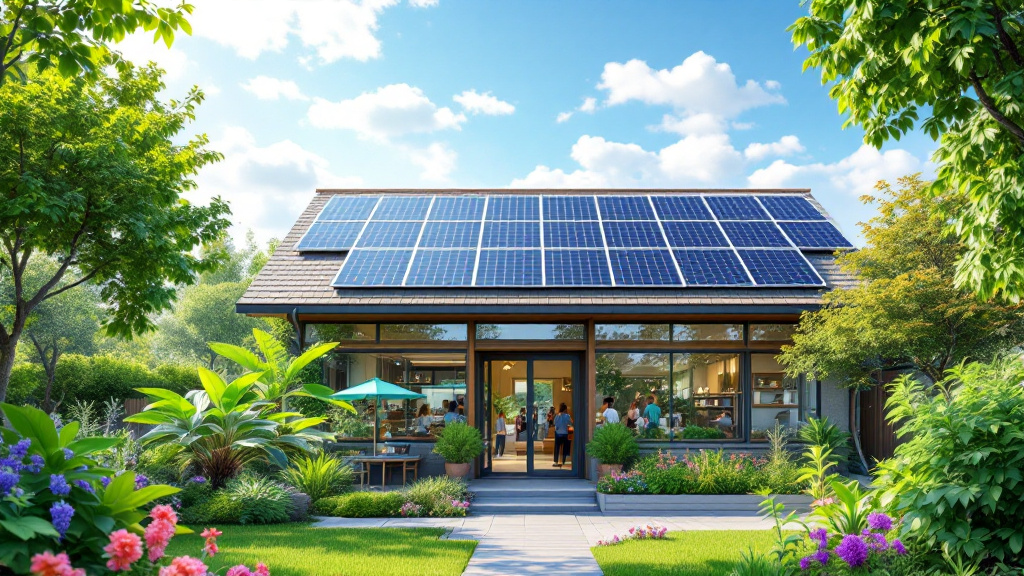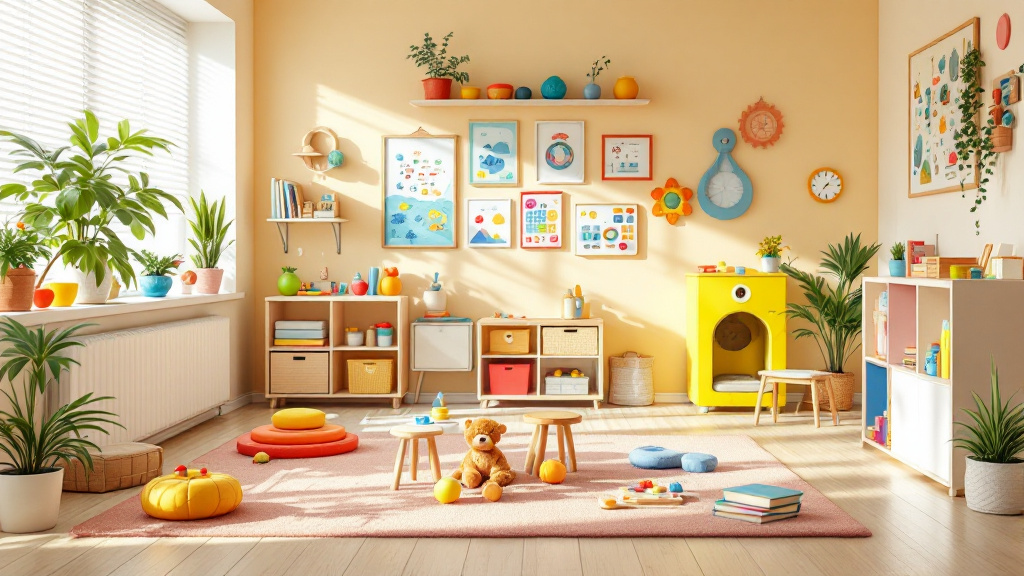Energy-Saving Tips for Autism Families
Essential Strategies for Energy Efficiency in Autism Homes


Understanding the Connection Between Energy and Autism
Families with autistic members often face unique challenges in creating energy-efficient and sensory-friendly living environments. This article delves into actionable strategies to enhance comfort while reducing energy consumption, exploring how families can achieve a harmonious balance between energy efficiency and sensory needs.
General Energy-Saving Strategies for Autism Families

What are some general energy-saving strategies for families with autistic members?
Families with autistic members can implement various energy-saving strategies that align with their unique needs.
Energy-efficient appliances such as those labeled with Energy Star can save families between $100 to $150 annually on their utility bills. These appliances operate quietly, reducing distractions for individuals sensitive to noise.
LED lighting is another effective strategy. Switching to LED bulbs can reduce energy usage by up to 75% compared to traditional incandescent lights. LED bulbs consume less energy, emit less heat, and offer customizable brightness and color settings, which help create a soothing environment for sensory-sensitive individuals.
Smart home technologies further optimize living spaces. Smart thermostats can adjust heating and cooling automatically based on family routines, maintaining consistent indoor temperatures vital for emotional stability. Automated lighting systems allow families to customize light intensity, reducing harsh lighting that may be overwhelming.
Creating quiet spaces in the home adds to the comfort level for autistic individuals. Designating areas with calming colors, sound-absorbing materials, and soft lighting provides retreats during overwhelming moments. These adjustments not only enhance comfort but also support energy-saving efforts by creating a more efficient and adaptive living environment.
Implementing these strategies, along with seeking financial support programs for energy-efficient upgrades, can help alleviate the costs of autism care while promoting greater comfort and stability for families.
Lighting for Sensory Comfort and Energy Efficiency

How can energy-efficient lighting contribute to a comfortable sensory environment for individuals with autism?
Energy-efficient lighting, especially LED technology, plays a crucial role in fostering a comfortable sensory environment for individuals with autism. Here are some key benefits:
Consistent Brightness: LED lighting provides uniform brightness without flickering, minimizing sensory overload. This reliability is essential for individuals who may be sensitive to light variations.
Customizable Options: Smart lighting systems offer adjustable brightness and color temperature, allowing families to tailor the lighting to their specific sensory needs. This flexibility promotes comfort and can enhance emotional stability.
Reduced Energy Costs: By using LED bulbs, families can save up to 75% on energy usage compared to traditional incandescent bulbs. This reduction not only lowers utility bills but also encourages eco-friendly practices.
Integration of Natural Light: Maximizing natural light in homes also supports mood regulation and can foster healthier sleep patterns. Incorporating windows and skylights makes spaces feel more open and less claustrophobic.
In conclusion, creating sensory-friendly spaces with energy-efficient lighting not only enhances comfort but also supports functional engagement while reducing energy costs. By prioritizing lighting solutions tailored to autistic individuals, families can create a more conducive environment for well-being.
Sustainable Design Principles for Autism-Friendly Homes

Which sustainable design principles can enhance comfort for autistic individuals while saving energy?
Sustainable design principles play a pivotal role in creating comfortable, energy-efficient environments tailored for individuals with autism. Incorporating natural lighting is a simple yet effective way to improve the atmosphere in the home. By allowing sunlight to illuminate spaces, families can reduce their reliance on artificial lighting, which can often be harsh and fluctuating. This not only saves energy but also creates a warmer, more inviting environment.
Proper Insulation: A Layer of Comfort
Insulation is another crucial aspect of sustainable design. Proper insulation minimizes heat loss during winter and heat gain in summer, maintaining a stable indoor temperature. For individuals sensitive to temperature shifts, this consistency fosters a sense of security and calmness, reducing anxiety linked to environmental changes.
Soundproofing for Serenity
Incorporating soundproofing materials, such as acoustic panels and rugs, can significantly diminish noise pollution, helping to create a peaceful living space. Reducing auditory distractions is essential for individuals with autism, who may experience heightened sensitivity to sounds. Designating quiet spaces in the home equipped with soft furnishings, dimmed lights, and sound-absorbing elements provide retreats for moments of overwhelm.
Biophilic Design: Nature’s Influence
Adopting a biophilic design approach adds another layer of comfort by integrating natural elements, such as indoor plants and organic materials. This connection to nature encourages emotional regulation and offers calming sensory experiences. Green spaces, even within the home, can promote relaxation and a sense of well-being.
Incorporating non-toxic and organic materials enhances indoor air quality, contributing to an overall supportive living environment.
By blending these sustainable design principles, families can create autism-friendly homes that not only save energy but also prioritize comfort and emotional stability.
Behavioral Strategies for Energy Management
What behavioral strategies can families adopt to improve energy efficiency in homes with autistic individuals?
Families can adopt several behavioral strategies to improve energy efficiency in homes catering to autistic individuals, beginning with the establishment of energy-saving routines. Engaging all family members, particularly those on the spectrum, in energy-saving activities can enhance understanding and adherence to these practices. For example, embracing the use of LED lighting or explaining the benefits of energy-efficient appliances can foster a sense of ownership over energy consumption decisions.
Smart Technologies: A Helping Hand
Incorporating smart home technologies is another effective strategy. Implementing smart thermostats, for example, allows families to manage heating and cooling according to established routines, adapting to the specific needs of sensory-sensitive individuals. These devices can automatically adjust indoor temperatures, minimizing discomfort and contributing to energy savings. Automated lighting systems can also create a calming environment, allowing for personalized settings that cater to individual sensory preferences, further promoting energy efficiency.
Routine Management for Consistent Energy Use
Routine management plays a crucial role in energy conservation. Establishing daily schedules helps prevent energy spikes by ensuring that devices are used judiciously. For instance, visual aids can assist in reminding family members to turn off unnecessary lights or unplug devices when not in use. Noise control measures, such as using sound-absorbing materials, can enhance comfort, leading to a more relaxed atmosphere and less energy drain from stress-associated behaviors.
By implementing these behavioral strategies, families can create supportive, energy-efficient homes that meet the unique needs of their autistic members, ultimately promoting both well-being and financial savings.
Integrating Smart Home Technology
What are some ways to integrate smart home technology for energy management in houses with autistic occupants?
Integrating smart home technology for energy management in homes housing individuals with autism can significantly enhance comfort and efficiency. Here are a few essential technologies:
Smart Thermostats: These devices learn the family's routine and occupancy patterns, adjusting heating and cooling automatically to maintain a stable indoor environment. This feature minimizes discomfort from temperature changes, which is especially important for those with sensory sensitivities. Studies show they can reduce energy consumption by 10-15% while ensuring a comfortable climate.
Adaptive Lighting: Smart lighting systems allow customization of brightness and color temperature. By adapting the lighting to meet specific sensory preferences, it helps mitigate sensory overload and create a soothing atmosphere. Dimmers can adjust light intensity, making environments more relaxing and conducive to focus.
Voice-Activated Devices: These tools provide ease of access for individuals, allowing them to control lighting, thermostats, and other features using voice commands. This can significantly reduce anxiety related to sensory overload and preserve energy by managing devices more efficiently.
Energy Management Systems: Smart sensors can monitor energy usage patterns, alerting families to spikes in consumption. This feature can help in establishing daily routines that minimize unnecessary energy use, providing predictability and enhancing energy efficiency in autism-friendly homes.
These smart technologies not only streamline energy management but also create supportive environments geared towards the needs of residents with autism.
Benefits of Proper Insulation and Soundproofing
Indoor Temperature Regulation
Proper insulation plays a crucial role in maintaining stable indoor temperatures throughout the year. This is especially important for families with autistic individuals, as they often experience heightened sensitivities to temperature fluctuations. By reducing heat loss in the winter and minimizing heat gain in the summer, effective insulation helps create a comfortable living environment. This stability is essential for emotional well-being and can help reduce sensory overload that might occur due to uncomfortable temperatures.
Noise Reduction
In addition to controlling temperature, soundproofing materials greatly contribute to reducing noise levels within the home. Ambient noise can be particularly overwhelming for individuals on the autism spectrum, as they may be more sensitive to auditory stimuli. Utilizing sound-absorbing materials such as acoustic panels, rugs, and insulation can create a quieter and more serene atmosphere, allowing autistic individuals the chance to relax and recharge without the constant distraction of outside sounds. This promotes overall comfort and helps establish designated calm spaces within the household.
Sensory-Friendly Environments
Creating a sensory-friendly environment encompasses both temperature regulation and noise reduction. Insulation and soundproofing work together to establish a tranquil space where individuals with autism can thrive. Such thoughtful design fosters a sense of security and predictability, essential factors in managing routine-based behaviors common in autism. Incorporating these elements into homes not only aids in energy efficiency but also significantly enhances the comfort levels for families, allowing for a harmonious living experience.
| Benefit | Description | Impact on Autism Families |
|---|---|---|
| Temperature Regulation | Maintains stable indoor temperatures | Reduces discomfort and sensory overload |
| Noise Reduction | Minimizes intrusive sounds | Encourages calmness and relaxation |
| Sensory-Friendly Spaces | Combines temperature and sound control for a peaceful environment | Supports emotional stability and well-being |
Harnessing Solar Energy for Autism Homes

Why Opt for Renewable Energy?
Using renewable energy sources, particularly solar power, can significantly benefit families with autistic individuals. By harnessing solar energy, these households can achieve greater energy independence while also promoting a sustainable lifestyle.
How Do Solar Panels Help?
Solar panels offer tangible financial advantages, with savings ranging from $600 to $1,200 annually on electricity bills. This reduction in utility expenses allows families to allocate more funds towards essential autism care and therapy services.
What Are the Financial Benefits?
Investing in solar energy isn't just an eco-friendly choice; it's also financially savvy. By taking advantage of tax credits, rebates, and community resources, families can lower the initial costs of installing solar panels. These financial incentives can make transitioning to solar power more accessible, ultimately enhancing the overall well-being of families living with autism.
Benefits Overview
| Benefit Type | Description | Financial Impact |
|---|---|---|
| Renewable Energy | Provides sustainable and stable energy | Reduces reliance on fossil fuels |
| Solar Panels | Installations can lead to significant savings | $600 - $1,200 annually |
| Financial Incentives | Tax credits and rebates for installations | Lowers upfront costs |
Harnessing solar energy can foster a more comfortable and supportive environment for families, while aligning with their energy needs.”} ]} } ``` subprocess.run([
Quiet Spaces and Sensory-Sensitive Design

Calming Colors
Using calming colors in home design can significantly impact the comfort of individuals with autism. Soft hues like pastels or neutrals are less stimulating and can help create a soothing atmosphere that reduces anxiety.
Designated Quiet Areas
Creating designated quiet areas in the home can provide essential retreats for individuals needing a break from overwhelming stimuli. These spaces should be comfortable, incorporate sound-absorbing materials, and feature dim or adjustable lighting to promote relaxation.
Sensory Retreat
Establishing sensory retreats with gentle textures, familiar scents, and soft lighting can help individuals cope during stressful moments. Integrated sensory tools like fidget items or noise-canceling headphones can enhance the calming effect, aiding emotional regulation and promoting overall well-being.
The Role of Natural Materials and Air Quality
Non-toxic Materials
Using non-toxic materials in home construction and decor can significantly improve the living conditions for families with autistic individuals. Materials like low-VOC (volatile organic compounds) paints and organic textiles minimize exposure to harmful chemicals, which is essential for enhancing indoor air quality.
Indoor Air Quality
Good indoor air quality is crucial for the well-being of autistic individuals, who may be sensitive to pollutants. Utilizing effective ventilation systems and air purifiers can help remove allergens and improve overall air quality in the home. This creates a healthier space that accommodates their unique sensitivities.
Organic and Natural Elements
Incorporating organic and natural elements, such as natural wood finishes and houseplants, can further enhance the sensory experience within a home. These elements not only provide aesthetic benefits but also contribute to a calming atmosphere, promoting comfort and reducing anxiety for individuals on the autism spectrum.
Economical Energy Solutions for Autism Care
Energy Costs
Families with individuals on the autism spectrum often face unique challenges, especially regarding energy consumption. Sensory sensitivities and the need for consistent environmental conditions can lead to increased energy usage, resulting in higher utility bills. Reports suggest that implementing energy-efficient solutions can save these families between $600 and $1,200 yearly, allowing them to allocate more funds to essential autism support services.
Financial Support
To ease the financial burden, there are various programs and incentives available. For instance, the Low-Income Home Energy Assistance Program (LIHEAP) offers assistance to families to help with energy costs. Additionally, state incentives for energy-efficient modifications can also offset initial investment costs for solar panel installations or Energy Star appliances, facilitating a more sustainable home environment.
Socio-Economic Impacts
The socio-economic impacts of energy costs on autism families can be substantial. Higher energy expenses can siphon funds away from necessary therapies and educational resources. Adopting renewable energy solutions, like solar panels, not only provides families with energy independence but also frees up financial resources for autism-specific care, ensuring a more equitable distribution of personal, health, and educational services within the community.
Building Supportive and Sustainable Homes
Achieving energy efficiency while catering to the unique needs of autistic individuals is both a practical and compassionate goal. By implementing thoughtful design choices, utilizing smart technologies, and adopting suitable behavioral strategies, families can create supportive environments that are both energy-efficient and comfortable. This approach not only enhances the quality of life for autistic individuals but also contributes to long-term financial and environmental sustainability.
References
Find More Articles

How to Use ABA Strategies to Support Toilet Training

How to Use ABA Strategies to Support Toilet Training

Green Living Spaces for Autism Families

How ABA Therapy Supports Long-Term Independence and Life Skills

How ABA Therapy Supports Long-Term Independence and Life Skills

The Connection Between ABA Therapy and Emotional Regulation

How ABA Therapy Helps with Goal Achievement for Teens

How to Help Children Develop Self-Monitoring Skills with ABA Strategies

How to Use Prompting and Fading Techniques in ABA Therapy

How to Address Tantrums and Meltdowns with ABA Therapy

The Role of Visual Supports in ABA Therapy Sessions

How to Address Feeding Issues with ABA Therapy

How to Create a Structured Routine with ABA Techniques

How to Help Your Child Transition Between ABA Therapy and School

How to Address Impulsivity with ABA Therapy

The Connection Between ABA Therapy and Long-Term Skill Retention

How ABA Therapy Can Be Adapted for Different Learning Styles

The Connection Between Play and Learning in ABA Therapy

How to Make ABA Therapy Fun and Engaging for Your Child

ABA Therapy for Children with Severe Autism

How to Use ABA Therapy Techniques to Build Self-Care Skills

The Importance of Consistency in ABA Therapy Implementation

The Role of ABA Therapy in Teaching Self-Management Skills

How to Address Self-Stimulatory Behaviors in a Supportive Way

The Importance of Functional Communication Training in ABA Therapy

How Renewable Energy Supports Autism Communities

The Benefits of a Structured ABA Therapy Program

Creating Eco-Friendly Spaces for Autism

The Benefits of Parent-Implemented ABA Therapy Strategies

The Importance of Reinforcement Schedules in ABA Therapy

How to Support a Child with Autism in Group Learning Environments

The Connection Between ABA and Emotional Regulation

How ABA Therapy Helps Reduce Repetitive and Rigid Behaviors

Energy-Efficient Autism Community Resources

How to Use ABA Therapy to Reduce Excessive Repetitive Behaviors

The Role of Play in ABA Therapy

The Benefits of Combining ABA Therapy with Other Support Services

How ABA Therapy Helps Develop Self-Confidence in Children with Autism

How ABA Therapy Helps Develop Self-Confidence in Children with Autism

The Role of Play-Based ABA Therapy in Early Childhood Development

The Role of Goal-Oriented Sessions in ABA Therapy

How ABA Therapy Works: A Step-by-Step Guide

The Role of Self-Management Strategies in ABA Therapy

How ABA Therapy Supports Emotional Expression in Children

The Role of Parent Training in ABA Programs

How ABA Therapy Supports Positive Transitions Between Activities

How to Reinforce ABA Learning in Community Settings

The Role of Functional Behavior Assessments in Preventing Problem Behaviors

How School-Based ABA Therapy Supports Classroom Success

How to Choose Between At-Home and Center-Based ABA Therapy

How to Choose Between At-Home and Center-Based ABA Therapy

How ABA Therapy Helps Develop Conflict Resolution Skills

How to Identify the Best ABA Provider for Your Child

How to Use Token Economies in ABA Therapy

The Role of Peer Modeling in ABA Therapy Success

The Benefits of Naturalistic Teaching Approaches in ABA Therapy

What Is the ABCs of Behavior in ABA Therapy?

The Benefits of Group ABA Therapy for Social Skill Development

How to Encourage Positive Social Interactions with ABA Strategies

How to Introduce New Skills in ABA Therapy Without Overwhelming Your Child

The Benefits of Combining ABA Therapy with Other Interventions

Solar Power for Autism Support Networks

How to Address Hyperactivity with ABA Therapy

Common Misconceptions About ABA Therapy

Understanding the Principles of Positive Reinforcement

Understanding the Principles of Positive Reinforcement

Understanding the Principles of Positive Reinforcement

How ABA Therapy Supports Transitions Between Activities

Understanding the Principles of Positive Reinforcement

How to Identify and Celebrate Small Successes in ABA Therapy Progress

Understanding the Principles of Positive Reinforcement

How to Introduce Visual Schedules for Better Behavior Management

How ABA Therapy Can Reduce Self-Injurious Behaviors

How ABA Therapy Supports Academic Success

The Importance of Early Signs Recognition and ABA Intervention

How ABA Therapy Helps Improve Comprehension and Listening Skills

How to Use Visual Schedules to Support Your Child’s ABA Goals

How ABA Therapy Supports Self-Help Skills Like Dressing and Eating

How ABA Therapy Supports Behavioral Success in Community Settings

How ABA Therapy Helps Build Independence in Daily Activities

Building Social Skills Through ABA Therapy Techniques

The Role of School-Based Behavior Intervention Plans (BIPs)

The Benefits of Scripting and Role-Playing in ABA Therapy

How to Help Your Child Develop Coping Strategies with ABA Therapy

How to Address Hyperactivity and Attention Challenges with ABA Therapy

How to Help Your Child Develop Coping Strategies with ABA Therapy

How ABA Therapy Addresses Challenging Behaviors

The Importance of Social Skill Groups in ABA Therapy

How ABA Therapy Addresses Challenging Behaviors

The Role of Task Analysis in ABA Therapy for Teaching New Skills

How ABA Therapy Helps Improve Focus and Attention in the Classroom
%2520(1).jpeg)
Assessment Tools For People With Autism

Autism And Chronic Pain

How to Use Social Stories to Enhance ABA Therapy Outcomes

How ABA Therapy Helps Prepare Children for School Success

How School-Based ABA Therapy Can Improve Academic Performance

How to Address Resistance to ABA Therapy and Build Engagement

How to Use ABA Therapy to Develop Self-Help Skills in Daily Routines

How to Use Role-Playing in ABA Therapy for Skill Development
Contact us
North Carolina, Tennessee, Nevada, New Jersey, Utah, Virginia
New Hampshire, Maine
Massachusetts, Indiana, Arizona, Georgia
.avif)

